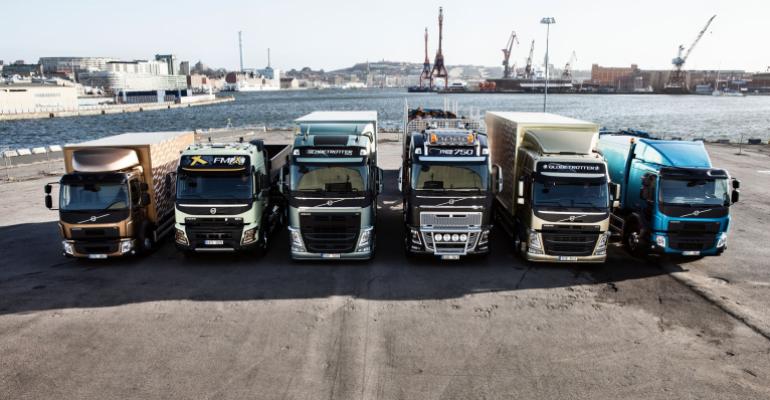BRUSSELS – The European automotive industry slams what it calls “excessively aggressive CO2 reduction targets” for new heavy-duty vehicles backed by the European Parliament, the European Union’s directly elected legislative body.
Members of parliament (MEPs) voted Nov. 14 in favor of Dutch Green Party MEP Bas Eickhout’s proposals, which said that by 2025, trucks must cut carbon-dioxide emissions by 20%, instead of 15% in the original proposal issued by the EU’s executive branch, the European Commission.
Also, under the parliament’s amendment to the proposed EU regulation, emissions levels for heavy-duty vehicles, including buses and any passenger vehicle with more than eight seats, by 2030 would have to be reduced 35% from 2019 levels instead of 30% proposed by the Commission.
Under the legislation as it is currently drafted, the Commission will review these targets in 2022. See https://preview.tinyurl.com/y8gwnege
Negotiations now will be held with the Commission and the EU Council of Ministers representing member states as the EU seeks agreement on a final legal text.
Before the vote, Eickhout noted truck emissions are being regulated “for the first time in European history,” while they already exist in Japan (since 2005), the U.S. (since 2011) and China (from 2015). He argued his proposed goals are possible with existing technologies, saying, “Cleaner trucks and other heavy-duty vehicles will lead to more innovation.”
But trucks already are highly efficient, Sigrid de Vries, secretary-general of the European Association of Automotive Suppliers (CLEPA), tells Wards. For example, she says, there is considerable CO2 reduction potential in truck platooning (convoys).
Fuel consumption is a key criterion for purchase decisions, de Vries adds. “This drives efficiency in the fleet.”
For CLEPA, increasing targets risks setting regulatory boundaries that exceed what is technically feasible for the trucking sector. “Furthermore, depending on the category of truck, the deployment and viability of technology options such as hybridization and electrification is much more limited,” de Vries says.
Erik Jonnaert, secretary general of ACEA, the main European automakers’ group, agrees: “These targets go over and above the proposal made by the European Commission last May, which was already very challenging,” he said after the Nov. 14 vote. For ACEA, “realistic” targets would be 7% emissions cuts by 2025 and 16% by 2030. (See http://tinyurl.com/y8a83rhz for original Commission proposal).
Jonnaert argues MEPs in their votes “are blatantly ignoring” that the situation is different for trucks, so targets should be lower than those set in a January 2018 proposal for a regulation setting new emissions limits for new cars and vans within the EU: 15% cuts by 2025 and 30% reductions by 2030 compared to 2021 levels.
The parliament’s proposed 2025 target would require truck makers to fit new technologies to vehicles already under development, even if this was not originally planned, Jonnaert says. “The R&D and production processes of the European truck industry would be negatively affected by these targets, for which the short lead time simply doesn’t match the long development cycles for trucks,” he adds.
MEPs also say that by 2025, the EU market share of zero- or low-emission vehicles (ZLEVs) (below, left) must be 5%. And by 2030, 20% of new cars must be ZLEV, to encourage manufacturers to shift to new technologies.
ACEA welcomes “in principle” this proposal to be achieved via so-called super-credits (incentives within manufacturers’ emissions-measurement formulas to provide vehicles with extremely low emissions), although recommending – contrary to the Commission proposal – that there should be no cap on these credits in the 2020-2025 period.
However, the trade group contests the MEPs’ call for a benchmark system that would penalize manufacturers that do not sell a mandatory quota of ZLEVs. Moreover, it argues these quotas are “extremely high.”
Emphasizing the sector wants to lower CO2 emissions as quickly as possible, Jonnaert is pushing for a “well-balanced regulation which encourages, supports and accelerates the technological shift towards low- and zero-emission powertrains, without jeopardizing industry’s competitiveness.”
The ACEA chief also says there was a weak majority for Eickhout’s proposals (by 373 votes to 285 with 16 abstentions), so he hopes national governments “will take a more balanced approach when adopting their common position (preliminary agreement) on future CO2 targets” for trucks.
MEPs are preparing the political groundwork by starting negotiations with the Council of Ministers, with ongoing meetings of a council working party, most recently Nov. 26. The proposal also will be on the agenda of the Dec. 20 EU Council of Ministers meeting on the environment, a Council spokesperson says.
 "Once the Council has reached its position, we are ready for trialogue negotiations with the Parliament, which we hope to start in January,” the spokesperson tells Wards.
"Once the Council has reached its position, we are ready for trialogue negotiations with the Parliament, which we hope to start in January,” the spokesperson tells Wards.
In the U.K., while uncertainty over Brexit continues, automakers likely will need to follow these stringent rules as Prime Minister Theresa May’s withdrawal agreement – valid at least until a scheduled Dec. 11 House of Commons vote on her Brexit deal – says Britain’s environmental laws must be as green as those in the EU after it quits the bloc.
The deal says any EU decision or regulation adopted before the end of a proposed transition period (planned to last until January 2020) will remain binding in Britain.
This would be welcome news for the U.K.’s Society of Motor Manufacturers & Traders. Calling for certainty and secure interim arrangements in its Brexit position paper, SMMT highlights emissions and Euro standards as a priority policy area when seeking to secure regulatory harmonization with the EU.





